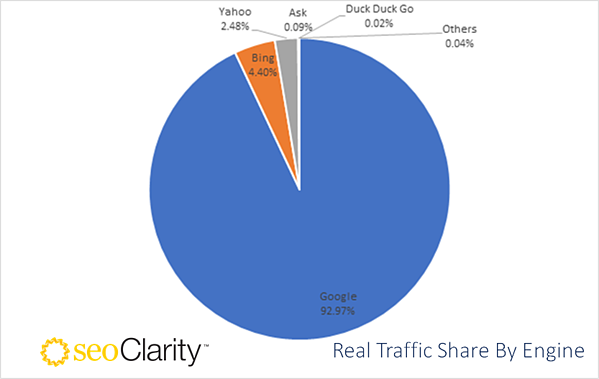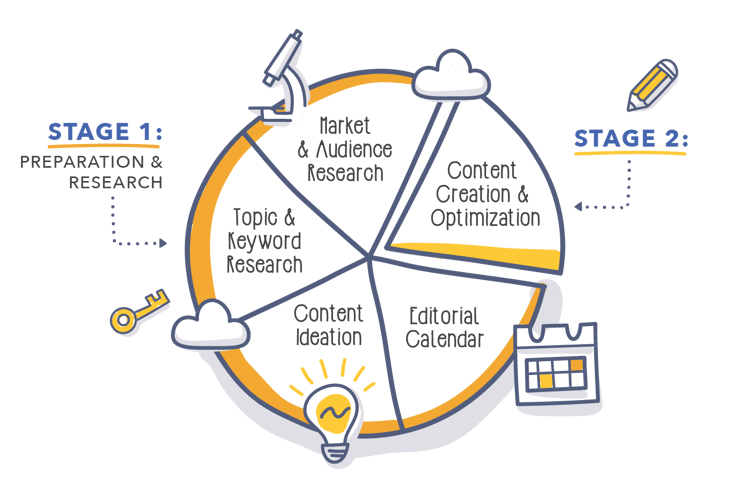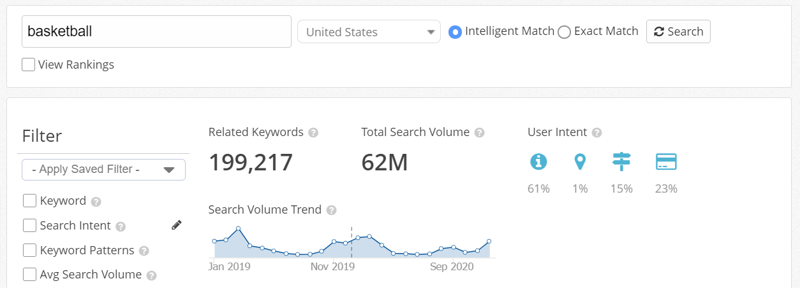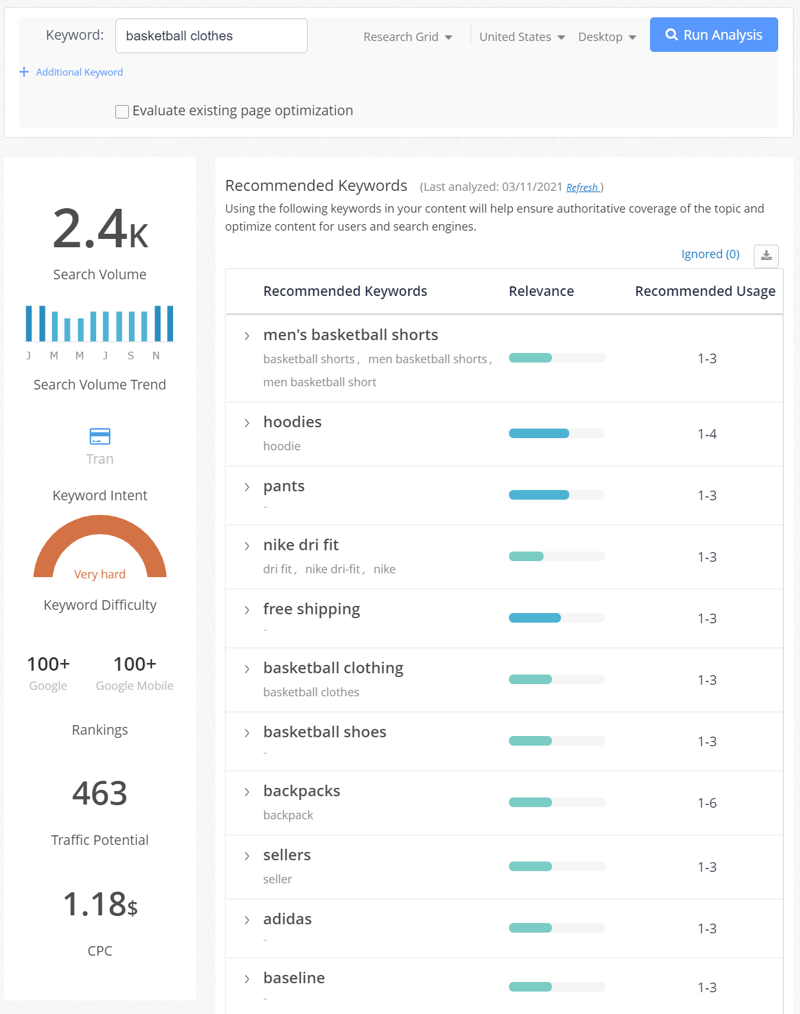Having quality content that satisfies the user's intent directly impacts user engagement, search engine rankings, and authority within your niche. That's why content is often the core element of many SEO strategies.
So, how do you plan and execute a successful content marketing strategy to drive rankings, organic traffic, and leads? That’s exactly what you’ll find out from this guide.
We’ll not only define what an SEO content strategy is, why you need it, and what it involves, but we’ll also walk you through the process of developing a winning strategy for your brand.
At the end of this guide, you’ll be able to answer the most common questions about an SEO-driven content strategy and know the steps you should take to create one.
Table of Contents:
- Who is an SEO Content Strategist?
- What is an SEO Content Strategy?
- Why Do You Need an SEO Content Strategy in the First Place?
- What’s Involved in Creating an SEO-Focused Content Strategy?
- Stage I. Preparation and Research
Plus, we're offering a free download of our content marketer's guide to a data-driven content strategy. This comprehensive guide dives even deeper into key metrics of engagement, strategies to become a subject-matter expert, a data-driven content strategy checklist, and more!
Who is an SEO Content Strategist?
An SEO Content Strategist is the person responsible for aligning content creation with SEO best practices to achieve business goals. They ensure that content drives organic traffic, engages audiences, and supports overall marketing objectives.
Key Responsibilities of an SEO Content Strategist:
- Keyword Research: Conduct in-depth research to identify target keywords and search intent.
- Content Planning: Develop frameworks and editorial calendars to guide content creation.
- Data Analysis: Analyze performance metrics to refine strategies and optimize content.
- Collaboration: Work closely with writers, designers, and technical teams to ensure content is optimized for search engines and user experience.
By combining data-driven insights with creative strategies, an SEO Content Strategist maximizes a site's visibility and impact.
Key Reasons to Invest in an SEO Content Strategist:
- Drives Measurable Results: A strategist ensures every piece of content is designed to achieve specific goals, like boosting traffic, increasing engagement, and driving conversions.
- Maintains Consistency: They oversee content efforts across teams, ensuring consistency in tone, messaging, and alignment with your brand’s objectives.
- Balances SEO and User Experience: A strategist ensures technical SEO requirements—like site speed, mobile-friendliness, and structured data—are met while also delivering content that’s valuable and easy to consume.
- Adapts to Changing Trends: They continuously analyze data and refine strategies to stay ahead of shifting user behaviors and search engine updates.
What is an SEO Content Strategy?
To understand the concept fully, we must consider its two core elements – SEO content and the strategy – separately.
SEO content refers to any information created with a single goal in mind – to rank higher in search results and establish credibility and trust with your online audience.
Writing such content involves applying SEO principles (both the basics and technical components) to different content types – pillar pages, product pages, blog posts, infographics, slideshows, guides, videos, evergreen content, and countless others.
Creating the content also involves understanding a specific user intent behind target keywords for the content.
An SEO content strategy, on the other hand, describes a plan to build an audience and generate leads by publishing, promoting, and ranking content that matches the user intent and delivers on their expectations.
In a nutshell, it defines who you’re targeting, what information you’ll provide, how you’ll deliver it, and what you aim to achieve.
Before we go through the process in-depth, we must address one more issue:
Why Do You Need an SEO Content Strategy?
An SEO content strategy is vital because it ensures your content aligns with user searches and preferences.
In today's digital age, Google drives nearly 93% of traffic to websites. People turn to Google for everything, from seeking information to finding products and services.

Your content, therefore, is your ticket to becoming a part of their search journey.
We define SEO content writing as "the marriage of crafting a great story with SEO best practices." It’s not just about satisfying your audience's interests and search intent; it’s about ranking well in the Search Engine Results Pages (SERPs) to reach potential customers.
Doing so allows you to position your brand along each step of the buying cycle, and start building a relationship with potential customers that is based on the value provided.
So if you have a good feeling about your audience and what they want, is there a need to formalize this knowledge any further?
Absolutely! In fact, having a well-documented SEO and content strategy helps your brand in three ways:
1) Provides a more structured approach
Without a strategy, your ideas lack structure. A content strategy transforms intuition into actionable strategies that your entire team can leverage to attract more visitors and leads.
2) Helps develop a unique voice and market positioning
Amidst the vast sea of online content, a content strategy helps you define your own unique voice and market position, setting your brand apart from competitors.
3) Brings focus to your efforts and ensures success
Ultimately, having an SEO content strategy assures you that you’re publishing content that is actually valuable. By satisfying the needs of your target audience and optimizing pages to highlight your authority, you'll be rewarded with higher rankings.
That’s precisely why it is one of the key factors that separate top content performers from laggards.
What’s Involved in Creating an SEO-Focused Content Strategy?
Before we get into the details of planning your strategy, let’s look at a 30,000-foot view of what you’ll need to do.
A solid SEO content strategy focuses on five key areas:
- Market and audience research which helps you understand who you’re targeting better, learn about their needs, and understand how to satisfy them.
- Topic and keyword research that helps you discover what problems or topics will deliver the biggest ROI from your efforts.
- Content ideation to define what each content piece is going to be about.
- Editorial calendar that prioritizes content throughout the entire strategy (or 12 months, at least).
- Content creation and optimization when you write your content and sprinkle on-page SEO on it to make sure it can outrank the competition (while delivering insane value to readers).

Let’s go through each step in turn.
Note: To simplify the process, I grouped the five elements above into two stages. The first one focuses on preparation and research. The other defines how to write and optimize your content.
Stage I. Preparation and Research
Below, you’ll discover what steps you need to take to:
- Collect all the necessary insights for your strategy.
- Identify specific content opportunities - topics, keywords, and ideas to create.
Please note, what follows is a generic overview of every step in the process. However, where applicable, I shared detailed guides that will help you learn more about a specific step.
Step 1. Determine Your Niche or Industry
The first step in creating a winning SEO content strategy is to define your target niche or industry.
Your best customers use different keywords, focus on different intents, and seek different information depending on your market.

For example, let’s pretend that you devise a content strategy for a basketball apparel store.
At first sight, it may seem that you could write about everything pertaining to the game and still attract relevant organic traffic.
And yet, when I analyze the topic through Topic Explorer, I discover something interesting. Of the total 80 thousand keywords relating to basketball, only 10000 are used in connection with the apparel niche!
Total Keyword Opportunity

Keywords in the Apparel Niche

So, what about the rest? These are phrases relating to anything from sports discipline, hobbies, health to jobs in the industry, electronics, and a lot in between.
By identifying your target industry or niche, you reduce the possibility of targeting keywords that are irrelevant to you.
Step 2. Define Your Target Audience and Their Pain Points
Next, decide who you’re targeting with the content. This is a critical step as understanding your specific audience and their pain points ensures that the content you produce will always be relevant.
There are many ways to identify the audience. I always recommend the following:
- Evaluate your current best customers and look at what they have in common. You can also survey those people to understand their needs and desires better.
- Conduct competitive research and identify who those companies try to attract. You can do so by evaluating their top keywords, the content, and their social media following.
- Create buyer personas based on the data in your customer base coupled with any demographic data you can find online.
Step 3. Topic Research
At this stage, you have all the insights to start researching potential keywords for your content. But that wouldn’t be wise.
You see, the way we search for information has changed tremendously over the last few years. In the past, Google wasn’t capable of evaluating complex queries. As a result, we had to use well-defined keywords.
We had to type “best running shoes” or “best runners.”
Today, with RankBrain and the Hummingbird update, the search engine can understand even the most complex queries and deliver the right information.
So, you can look for “running sandy beach shoes” and you’ll find exactly what you’re looking for.
But this change also means that customers can now use ANY query to find information. As a result, we can safely assume that there are countless possible keywords they could type into the search box.
All those keywords, however, belong to an entity we refer to as topics. The idea of topics in keyword research is vast, exceeding the information that we can include in this guide. Don't worry, though: I’ve listed some recommended reading to help you learn more about it below.
In general, however, topics are overarching ideas about the subject of the search (i.e. “SEO,” “basketball,” Jogging”)
Topics do not define what the person is searching for, specifically. Instead, they define specific areas of interest of your audience and allow you to be highly specific with the keyword research.
Recommended Reading: Why Topic Strategy Matters Most in Keyword Research
Step 4. Keyword Research
With the topics at hand, you’re finally ready to research keywords to target with the content.
In short, you’re looking for phrases that relate to your target topics, and have the opportunity to attract visitors to the site (measured by the keywords Search Volume, among other factors.)
During the research process, you also evaluate each keyword for the user intent to ensure that you provide relevant information.
Recommended Readings:
- Build Content that Drives Authority with Topic Explorer, Our Topic Cluster Tool
- What Users Want: Dissecting the Challenge of Matching User Intent to Keywords
- How to Use Semantic Terms to Support Your Content
- How to Identify and Close Your Content Gaps (Hint: You Must Rely on Your Competition)
- User Intent Uncovered: What You Need to Know to Scale
Step 5. Develop Content Ideas
This is the step when you devise specific SEO content ideas based on the research you've conducted so far.
I realize that it’s not easy to discover what to write on each topic, so let me offer some advice:
Review the top-ranking content for each keyword manually. See if there are patterns among those pages. This might shed some light on the audience’s expectations.
Use Content Fusion. This AI-powered content editor analyzes the keyword against many data points and delivers insights to help you authoritative content.
In addition to generating content briefs based on the top-ranking content for your target keywords, it even uses generative AI to automatically create content outlines and paragraphs based on your customized content profile.

Step 6. Define Your Angle
Companies often spend a significant amount of time on understanding their audience, their pain points, and so on to create relevant content. Yet, they rarely consider how they could differentiate it from the competition.
But with thousands of new content pieces published every day, the only way to connect with the audience is by having a distinct angle.
Now, it doesn’t mean that you have to write completely unique information. With so much content out there, it wouldn’t even be possible.
Finding a unique angle means defining your story or approach to what you’re writing about.
Take us, for example. No matter what we write about – keyword research, SEO content, link building, you name it – we always approach those topics from a specific angle.
We become a single source of everything a client could possibly need regarding enterprise SEO. From technology, support, training, consulting, and beyond. That level of care and the willingness to share our insights shows in our writing too.
So, find your angle. It will give your content a distinct voice, and connect you with the right customers.
Step 7. Audit Your Existing Content
Most of the advice we’ve shared so far has revolved around identifying your market. The remaining three points in this section go one step further.
They focus on preparing your specific content ideas. And the process should begin with a thorough evaluation of your existing assets – an SEO content audit.
Why audit your content?
First of all, you want to understand what assets you already have and how they’ve been performing so far.
With this information, you can:
- Identify which topics have engaged the audience the most (and the ones your readers keep ignoring).
- Discover which pages to improve and boost their search performance.
- Pinpoint assets to trim from the site.
Step 8. Assign KPIs to Measure Success
In this step, you need to choose the best metrics to monitor how well you’re achieving the main goals of your content strategy. These metrics are known as your KPIs (key performance indicators)
If you aim to increase brand awareness, you might want to track organic traffic and online brand mentions. When you aim to generate leads, your KPIs would revolve around the number of new visitors to the site and their conversion rates, and so on.
Recommended Reading: The Most Important SEO KPIs to Track for Enterprise Business (and Which Ones Aren't Worth Your Time) and Highlight Your Wins With Custom SEO Dashboards - Examples Included!
Stage II. Content Creation and Optimization
In this section, you’ll find advice on how to create fully optimized, SEO-driven content.
Just like with the section above, what follows are generic overviews of each step in the process. However, you’ll also find recommended reading to help you learn more about the relevant steps and discover how to implement them in practice.
The activities I recommend paying attention to when creating content include:
Step 9. On-page Optimization
Most of your optimization relates to on-page elements.
Although there is no one-size-fits-all formula for writing SEO content, there are certain elements a well-written and well-optimized piece must include:
- Use the keyword in the meta title and description.
- Feature the keyword in the H1 tag (and in H2 too, ideally).
- Create a logical headings structure that helps people to scroll to whatever information interests them the most.
- Make your content relevant by including semantic-related keywords throughout the copy.
- Verify you've covered the topic with complete authority.
- Include information that matches the user intent for the keyword. This also means avoiding stuffing the content with unnecessary or irrelevant information.
- Strong and engaging meta title and description that captures users' attention in the SERP.
- Include a unique point of view within your content.
- Ensure a high engagement rate with your content (more on this in the next step,) and much more.
Recommended Reading: How to Write Optimized Page Title Tags
Engagement
Dwell time – how much time people coming from the search engine spend on your page – plays an incredibly important role in rankings and driving your user further into your site. In fact, as some SEOs point out, it’s the engagement signals that get you to the top of the SERPs.
The most common ways to increase engagement include featuring videos, visuals, infographics, and other elements that attract the reader’s attention and hold them on a page longer.
Recommended Reading: 8 Tricks to Creating Engaging Content
But engagement shouldn’t happen by accident. It should be the result of careful planning to provide an optimal user experience. Here are some ideas to help you achieve it:
- Review whether other top-ranking content features any engagement elements (videos, visuals, graphs, etc.)
- Analyze your URLs with the highest dwell time to identify which elements engage the audience the most (hint: use a heatmap software on those pages to find out where users spend the most time,)
- Ensure that you cover the topic in-depth, leaving no information out. Such a page is bound to retain readers for longer. Use Content Fusion to identify the information your copy should include, and build it from that.
Interlinking
Internal links connect pages on the same domain. They help point readers to other, relevant information to find out more on the topic.
But internal links also help SEO. Thanks to them, Google can discern the content of the linked page. Not to mention that interlinks pass link equity between pages, allowing you to strengthen new content by passing the authority from higher-level assets.

As part of the SEO content strategy, I recommend identifying interlinking opportunities for each new content asset. By creating those internal connections, you’ll help to establish that page in your topic cluster and boost its chances of ranking well.
How to Use the Content Strategy Effectively
First of all, your SEO content strategy must inform various content-related workflows within the business. The strategy defines all aspects of the content, but also, the content production. Based on that information, you can specify who is responsible for its various aspects, when, and how they should proceed.
With that, you’ll have no problems with converting your organization into a well-oiled content machine. Coincidentally, this is precisely what sets the best content performers from laggards apart.
Another way to use the strategy is to simplify the decision-making. Every time something within the organization changes - a new product gets launched, for example - and the change affects your content, the strategy will keep you grounded, and help make the right decisions faster.
All in all, you use the strategy as the foundation for everything content-related that you do, from ideation to production to ensuring consistency and productivity.
Conclusion
Here is a run-down of all of the steps on how to create a winning SEO content strategy:
- Stage I. Preparation and Research
- Step 1. Determine Your Niche or Industry
- Step 2. Define Your Target Audience and Their Pain Points
- Step 3. Topic Research
- Step 4. Keyword Research
- Step 5. Develop Content Ideas
- Step 6. Define Your Angle
- Step 7. Audit Your Existing Content
-
Step 8. Assign KPIs to Measure Success
- Stage II. Content Creation and Optimization
- Step 9. On-page Optimization



.png?width=140&name=Untitled%20design%20(10).png)


1 Comment
Click here to read/write comments